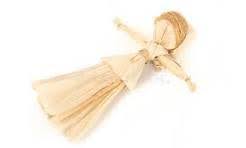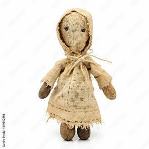
By
Marilyn Carnell
In the 21st century, children, at least
many American children, are inundated with toys. When I was a child that
was not the case. Toys are always a part of childhood as it is a way
for children to mimic what adults do and begin to learn how they will
behave as adults. Before the presence of ubiquitous plastic, only
readily available materials were used to create toys, especially dolls.
They could be as simple as a corn husk or a feed sack doll.

 |
At the other end of the spectrum were elaborate (and expensive) porcelain dolls.

|
|
I was born in 1940 at the end of the Depression and on the cusp
of WWII. Both circumstances led to shortages and a lack of resources. It
was more important to use your ration book for gas, tires for the car,
or groceries that were limited than on a frivolous toy.
I recall having the following toys during the war: a baby
doll, a panda bear, and a male doll I called a “Soldier Doll”. I don’t
recall feeling deprived.
There were many ways to amuse myself
and, as the baby of my mom’s family, I had many family members to
entertain me. My siblings and cousins read stories to me, so I learned
early the value of books. They also played games with me and taught me
to recite rhymes and sing little ditties. The first song I learned was a
popular tune during WWII called Mairzy Dotes (Mares Eat Oats). From
that, I learned I liked to perform and be the center of attention.
As I grew older and went to school, I learned games like Red
Rover and other active games to blow off steam from the classroom.
Another fond memory is that the girls would rush outside at recess to
create “houses” between the roots of trees that surrounded the
playground. We found small pebbles to outline the rooms and found items
like acorn caps to make pretend dishes. I had a classmate who brought us
chinquapins (American chestnut). They looked a lot like acorns, but
had a bristly cap. Not only did they bring something new to our supply
of “dishes” the nuts were quite tasty. Sadly a blight destroyed most of
the chinquapin trees, so they are no longer available.

|
|
Of course, there were simple games. I loved rainy days in the 4th grade because we stayed in the classroom and played Jacks.

|
|
Dominoes were fun to arrange in a line and knock them over. I
never actually played the game that adults found interesting. Card games
offered another opportunity to play, but are probably not thought of as
toys.
I remember being taught how to manipulate a circle of string
into a “cat in a cradle” or make a shadow of a bunny by holding my
fingers in front of a light in a certain way to cast a shadow on the
wall of a long eared creature. I loved doing those things.
All in all, I don’t think I missed much by having few toys.
In creating my own amusements and interacting with others, I stretched
my imagination and learned the joy of simple pleasures.





No comments:
Post a Comment